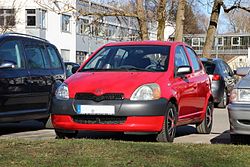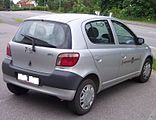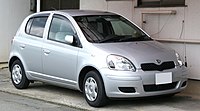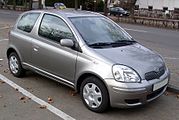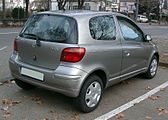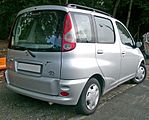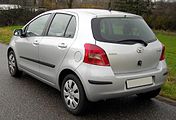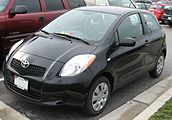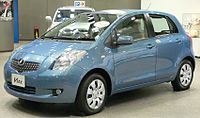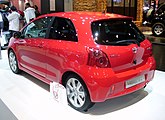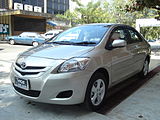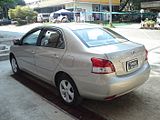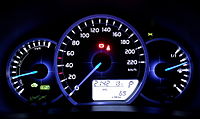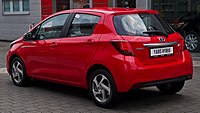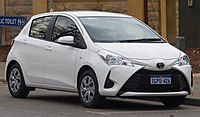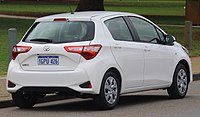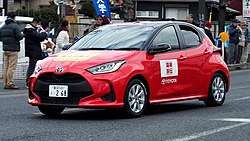Toyota Yaris
| Toyota Yaris | |
|---|---|
| Production period: | since 1998 |
| Class : | Small car , minivan |
| Body versions : | Station wagon , station wagon |
| Previous model: | Toyota Starlet , Toyota Tercel |
The Toyota Yaris is a small car from the Japanese car manufacturer Toyota , which was developed for the European and North American markets. The name, an artificial word with no concrete meaning, was created in 1997 by the Düsseldorf naming agency Nomen. In Japan it was sold as the Toyota Vitz until the introduction of the fourth generation , with a notchback as Toyota Platz .
The Yaris is built in Japan and for the European market, and between 2012 and 2019 also for North America , by Toyota Motor Manufacturing France in Onnaing ( Arrondissement Valenciennes , Northern France). The 2.5 millionth Yaris was produced there in April 2014.
The Yaris Verso minivan based on the first generation was available between 1999 and 2005 . Based on the fourth generation, Toyota presented the Yaris Cross sports utility vehicle in spring 2020 .
Yaris / Vitz (P1, 1998-2006)
| 1st generation | |
|---|---|
|
Toyota Yaris four-door (1999-2003) |
|
| Production period: | 1998-2006 |
| Body versions : | Station wagon , station wagon |
| Engines: |
Otto engines : 1.0–1.5 liters (48–78 kW) Diesel engine : 1.4 liters (55 kW) |
| Length: | 3615 mm |
| Width: | 1660 mm |
| Height: | 1500 mm |
| Wheelbase : | 2370 mm |
| Empty weight : | 820-1045 kg |
The first generation Toyota Yaris is the successor to the Toyota Starlet and the hatchback Toyota Tercel . There were Otto engines with 1.0 and 1.3 L, and the variable valve timing VVT -i and a 1,4-l- (D4-D) - common rail -Turbo- diesel engine (55 kW) to select, except for the Diesel engine, all engines are equipped with two overhead camshafts (DOHC) and four-valve technology. In addition, a sports version called the Yaris TS with a 1.5-liter VVT-i naturally aspirated engine and 105 hp was offered in some European countries. In Switzerland, a limited special edition with a 1.5-liter turbo engine with 110 kW (150 PS) called the Yaris TS Turbo appeared. Toyota's in-house tuner TTE also offers a compressor kit that brings the 1.5-liter engine to 140 hp. The Yaris was designed by Sotiris Kovos .
The dashboard is not arranged in front of the driver's seat, but offset to the center. In the combination instrument attached there, the instruments and indicator lights are shown by a fluorescent display. In contrast to the other models, the Yaris TS and TS Turbo do not have a fluorescent display, but rather conventional instruments, albeit in a central position.
The first generation was available in Europe from spring 1999, in the USA and Canada the notchback model and coupé came on the market as the Toyota Echo in summer 1999. While 48,876 copies were sold in the USA in 2000, the figure was 42,464 in 2001, 30,859 in 2002 and only 26,167 in 2003. The car is therefore not considered particularly successful there - in contrast to Germany, where it is Toyota's best-selling model. In the People's Republic of China , the Yaris P1 has been offered under the name Xiali Vizi since 2002 .
In spring 2003, the Yaris and Yaris Verso received a facelift.
In 2004, 22,536 vehicles of this type were newly registered in Germany. It was ranked 36th in the statistics. In 2005, the Yaris took fourth place in the ADAC breakdown statistics.
Yaris Verso
The Toyota Yaris Verso is a minivan based on the Yaris that was produced from autumn 1999 to mid-2005. In addition to the hatchback, which is called Vitz in Japan , and the Yaris Verso minivan, which is called FunCargo in Japan , a notchback variant was also offered, which was called Platz in Japan and Echo in the USA . However, this variant did not come to Europe.
Only from the beginning of 2011 there was a successor with the Toyota Verso-S .
Engines
| model | Displacement | cylinder | power | Torque | transmission | construction time |
|---|---|---|---|---|---|---|
| Petrol engines | ||||||
| 1.0 VVT-i | 998 cc | 4th | 48 kW (65 hp) at 6000 min -1 | 90 Nm at 4000 min -1 | Five-speed manual or five-speed sequential |
2003-2006 |
| 50 kW (68 hp) at 6000 min -1 | 90 Nm at 4000 min -1 | Five-speed manual transmission | 1999-2003 | |||
| 1.3 VVT-i | 1298 cc | 4th | 63 kW (86 hp) at 6000 min -1 | 124 Nm at 4400 min -1 | Five-speed manual or four-speed automatic |
1999-2003 |
| 64 kW (87 hp) at 6000 min -1 | 122 Nm at 4200 min -1 | Five-speed manual four-speed automatic |
2003-2006 | |||
| 1.5 VVT-i TS | 1497 cc | 4th | 77 kW (105 hp) at 6000 min -1 | 143 Nm at 4200 min -1 | Five-speed manual transmission | 2003-2006 |
| 78 kW (106 hp) at 6000 min -1 | 145 Nm at 4200 min -1 | Five-speed manual transmission | 2001-2003 | |||
| Diesel engine | ||||||
| 1.4 D-4D | 1364 cc | 4th | 55 kW (75 hp) at 4000 min -1 | 170 Nm at 1700 min -1 | Five-speed manual or five-speed automatic |
2002-2006 |
Model overview
Yaris / Vitz (XP9, 2005-2011)
| 2nd generation | |
|---|---|
|
Toyota Yaris five-door (2005-2009) |
|
| Production period: | 2005-2011 |
| Body versions : | Station wagon |
| Engines: |
Otto engines : 1.0–1.8 liters (51–98 kW) Diesel engines : 1.4 liters (66 kW) |
| Length: | 3785 mm |
| Width: | 1695 mm |
| Height: | 1530 mm |
| Wheelbase : | 2460 mm |
| Empty weight : | 980-1190 kg |
| Stars in the Euro NCAP - Crash Test |
|
At the end of 2005, the second generation of the Toyota Yaris was launched in Europe. Investments were made in a different form and in security. The Yaris II achieved in Euro NCAP - Crash test in October 2005 in the adult occupant protection with 35 points, the maximum of five stars; Only three stars for child protection with 34 points, which are due, among other things, to the lack of clear identification of both the Isofix bracket on the back seat and the deactivation of the passenger airbag. The notchback version that was not offered in Europe was called Toyota Belta .
The Yaris II offers a larger interior space than its predecessor. The Yaris II was offered in the variants Toyota Yaris 1.0 (petrol, 51 kW), Toyota Yaris 1.3 (petrol, 64 kW) and Toyota Yaris 1.4 D-4D (diesel, 66 kW). The higher trim levels in 2009 were Cool, Sol and Executive.
In January 2009 the Yaris underwent a facelift and there were a total of 20,811 new registrations in Germany.
Equipment
Two front and two side airbags , head airbags (curtain shield) at the front and rear and a driver's knee airbag are standard . ABS with electronic brake-force distribution (EBD), power steering, electrically adjustable mirrors, CD radio with four loudspeakers and a 60/40 split rear bench seat that can be adjusted lengthways by 15 cm are also available. The height adjustment of the driver's seat and electric windows were initially missing in the basic model.
- The Luna model, which is no longer available , had, among other things: radio central locking, rear disc brakes with electronic stability program (VSC, Vehicle Stability Control) including traction control (TRC, Traction Control) (with the current model only from the Sol model ), electric windows and larger ones Tires (185/60 R 15 instead of 165/70 R 14).
- The Cool model has radio central locking, air conditioning and larger tires (185/60 R 15 instead of 165/70 R 14), from the beginning of 2009 with a 1.33-liter engine with automatic start-stop (also in Sol and Executive installed).
- The Sol model (2005–2009) also has a height-adjustable driver's seat (included in the current basic model), a leather steering wheel that can also be adjusted lengthways with audio controls, heated exterior mirrors, CD radio with MP3 function, air conditioning and additional shelves. Only the Sol model additionally has the VSC with TRC (electronic stability program with traction control) as standard.
- The Life model replaced the Sol model on January 16, 2010 and now featured automatic air conditioning and analog displays as standard.
- The Yaris Executive offers automatic climate control, keyless door opening and closing and starting the engine with a start / stop button (smart key system), heated exterior mirrors, with five-door electric windows also at the rear, alloy wheels, fog lights and a Bluetooth hands- free system .
Yaris TS
The launch of the sports version Yaris TS took place on January 13, 2007. A newly developed 1.8-liter four-cylinder gasoline engine with variable valve control and an output of 98 kW (133 hp) served as the drive.
Engines
Four petrol engines with an output of 1.0 liters (51 kW), 1.3 liters (64 kW) and 1.33 liters (74 kW) are available for the Yaris II. For the top model Yaris TS there is a 1.8-liter engine with 98 kW and a 1.4 D-4D (66 kW) is available for the diesel engines. The 1.0-liter engine was named Engine of the Year 2007-2011. In order to meet the Euro 5 emissions standard, the 1.33 Dual VVT-i was revised in 2011 and has an output of 73 kW. In March 2009 the Toyota Yaris TS Bemani was available in Switzerland from every Toyota dealer from CHF 33,900.00. The 1.8 liter engine has an output of 158 kW / 215 hp via a compressor and delivers a maximum torque of 270 Nm at 4800 rpm.
| model | Displacement | cylinder | power | Torque | transmission | construction time |
|---|---|---|---|---|---|---|
| Petrol engines | ||||||
| 1.0 VVT-i | 998 cc | 3 | 51 kW (69 hp) at 6000 min -1 | 93 Nm at 3600 min -1 | Five-speed manual transmission | 2005-2011 |
| 1.3 VVT-i | 1298 cc | 4th | 64 kW (87 hp) at 6000 min -1 | 121 Nm at 4200 min -1 | Five-speed manual or five-speed automatic |
2005-2008 |
| 1.33 Dual VVT-i | 1329 cc | 4th | 73 kW (99 hp) at 6000 min -1 | 128 Nm at 3800 min -1 | Six-speed manual or six-speed automatic |
09 / 2010–2011 |
| 74 kW (101 hp) at 6000 min -1 | 132 Nm at 3800 min -1 | Six-speed manual or six-speed automatic |
2009-09 / 2010 | |||
| 1.8 TS VVT-i | 1798 cc | 4th | 98 kW (133 hp) at 6000 min -1 | 173 Nm at 4400 min -1 | Five-speed or (import only) six-speed manual transmission | 01/2007–01/2009 |
| 1.8 TS Bemani (CH) | 1798 cc | 4th | 158 kW (215 hp) at 6000 min -1 | 270 Nm at 4800 min -1 | Six-speed manual transmission | 03 / 2009-2010 |
| Diesel engine | ||||||
| 1.4 D-4D | 1364 cc | 4th | 66 kW (90 hp) at 3800 min -1 | 190 Nm at 1800-3000 min -1 | Five-speed manual or five-speed automatic |
2006-2009 |
Replicas
From spring 2011, the second generation was offered in a slightly modified form as Daihatsu Charade in Europe until the local Daihatsu sales in January 2013.
Yaris / Vitz (XP13, 2010-2020)
| 3rd generation | |
|---|---|
|
Toyota Yaris (2010-2014) |
|
| Production period: | 2010-2020 |
| Body versions : | Station wagon |
| Engines: |
Otto engines : 1.0–1.8 liters (51–156 kW) Diesel engine : 1.4 liters (66 kW) Otto hybrid : 1.5 liters (74 kW) |
| Length: | 3945 mm |
| Width: | 1695 mm |
| Height: | 1510 mm |
| Wheelbase : | 2510 mm |
| Empty weight : | 1055-1235 kg |
| Stars in the Euro NCAP - Crash Test |
|
The Toyota Vitz rolled off the assembly line in Yokohama (Japan) on December 22, 2010.
Since October 15, 2011, the third, significantly more angular generation of the Yaris or Vitz has also been available in European countries. The body shape is adapted to the other Toyota models of the same construction period.
On June 16, 2012, the Yaris was introduced as a Hybrid Synergy Drive model. This variant is made in France.
Equipment
Two front and two side airbags , head airbags (curtain shield) at the front and rear and a driver's knee airbag, internally ventilated disc brakes at the front ( drum brakes at the rear), ABS with electronic brake -force distribution (EBD), vehicle dynamics control (ESC ) are standard equipment Toyota VSC - called Vehicle Stability Control) including traction control (TRC, Traction Control) and electric power steering . The basic model has electrically operated front windows and exterior mirrors, central locking (on the driver's side), height and length adjustable steering wheel, audio preparation with six loudspeakers, height adjustment of the driver's seat (only with the five-door version of the Club and the Executive , the passenger seat is height adjustable) and one 60/40 split rear seat back.
- The Cool model has air conditioning, an RDS CD radio with MP3 function, radio central locking and larger wheels (175/65 R 15 instead of 175/70 R 14)
- The version Life in addition tachometer, leather steering wheel and shift knob in addition, the multimedia audio system "Toyota Touch" with 6.1 inches (15 cm) color monitor, rear view camera and Bluetooth - hands-free . The “Toyota Touch & Go” navigation system is only available for the Life, Club and Executive versions at an additional cost.
- In addition to the Life equipment, the Trend version has LED clear glass taillights and matt foiled C-pillars. In addition to the optionally available panoramic glass roof, this should give a floating, light look.
- The Yaris Club has rear disc brakes and is fitted with large light alloy wheels (195/50 R 16) that require a narrow run- flat wheel (all other cars have a tire repair kit ). The exterior mirrors are electrically heated.
- The highest version Executive , which is only available as a five-door with the 1.33-liter engine, has smaller light-alloy wheels (175/65 R 15) and is also equipped with electrically operated window regulators at the rear. With the automatic air conditioning , the temperature can be set separately for the driver and front passenger.
Yaris hybrid
The Yaris Hybrid is a full hybrid , the 1.5-liter petrol engine of the Prius II with 54 kW is used. The hybrid drive of the Yaris weighs 201 kg and is 42 kg or 20% lighter than that of the Toyota Auris Hybrid. Since the smaller battery is located under the rear seat bench, the Yaris Hybrid has the same trunk size as the conventionally powered Yaris. As with all other vehicles with Hybrid Synergy Drive , the driver can influence the electronics and select a purely electric or particularly economical operation by pressing the "EV button" or "ECO button". The Yaris has a NiMH battery with a capacity of 0.9 kWh at 144 volts, which enables purely electric driving up to a range of approx. 1.5 km and a maximum of 50 km / h.
The hybrid models from Toyota available in Switzerland are called: Yaris Luna Hybrid , Yaris Sol Hybrid and Yaris Sol Premium Hybrid .
Facelift
In August 2014 the Yaris was revised.
Its front was adapted to the recently renewed Aygo , which means it now also has a radiator grille in the so-called X design. LED taillights have also been integrated at the rear. Toyota geared the engines to lower fuel consumption and lower CO 2 emissions.
The Yaris underwent a further revision for model year 2017. Over 900 parts were replaced, comfort improved and the noise level reduced. In addition, the 1.33-liter engine was replaced by a more powerful 1.5-liter engine and a limited sports version Yaris GRMN ("Gazoo Racing Champion of Nürburgring ") with the 1.8-liter gasoline engine from the Lotus Elise as Offshoot of the WRC model introduced. There is no diesel engine. The revised Yaris went on sale on April 24, 2017 at prices from 12,540 euros.
Technical specifications
| 1.0 VVT-i | 1.33 Dual VVT-i | 1.5 Dual VVT-iE | 1.8 GRMN | Hybrid | 1.4 D-4D | ||
|---|---|---|---|---|---|---|---|
| Construction period | 10/2011–08/2018 | 08 / 2018–06 / 2020 | 10/2011–04/2017 | 04/2017–06/2020 | 01 / 2018-08 / 2018 | 06 / 2012-06 / 2020 | 10/2011–04/2017 |
| engine | Three-cylinder in- line engine | Four-cylinder in-line engine | Four-cylinder in-line engine + electric motor | Four-cylinder in-line engine | |||
| Mixture preparation | Manifold injection | Common rail direct injection | |||||
| Engine charging | - | compressor | - | Exhaust gas turbocharger | |||
| Valves | 12 ( DOHC ) | 16 (DOHC) | 8 (SOHC) | ||||
| Displacement | 998 cc | 1329 cc | 1497 cc | 1798 cc | 1497 cc | 1364 cc | |
| Bore × stroke | 71 × 84 mm | 72.5 x 80.5 mm | 72.5 x 90.6 mm | 80.5 x 88.3 mm | 75 x 84.7 mm | 73 × 81.5 mm | |
| Max. System performance | 51 kW (69 PS) at 6000 rpm |
53 kW (72 PS) at 6000 rpm |
73 kW (99 PS) at 6000 rpm |
82 kW (111 PS) at 6000 rpm |
156 kW (212 hp) at 6800 rpm |
74 kW (100 PS) | 66 kW (90 PS) at 3800 rpm |
| Max. Electric motor power | - | 45 kW (61 hp) | - | ||||
| Max. Internal combustion engine power | 51 kW (69 PS) at 6000 rpm |
53 kW (72 PS) at 6000 rpm |
73 kW (99 PS) at 6000 rpm |
82 kW (111 PS) at 6000 rpm |
156 kW (212 hp) at 6800 rpm |
54 kW (73 hp) at 4800 rpm |
66 kW (90 PS) at 3800 rpm |
| Hybrid battery performance | - | 19 kW (25 PS) 144 volts, 6.5 Ah |
- | ||||
| Max. Internal combustion engine torque | 95 Nm at 4300-6000 rpm |
93 Nm at 4400-6000 rpm |
125 Nm at 4000 rpm |
136 Nm at 4400 rpm |
249 Nm at 5000 rpm |
111 Nm at 3600-4400 rpm |
205 Nm at 1800-2800 rpm |
| Max. Torque electric motor | - | 169 Nm | - | ||||
| Empty weight | 1055-1115 kg | 1055-1125 kg | 1105-1170 kg | 1040 kg | 1135 kg | 1160-1235 kg | 1155-1235 kg |
| Gearbox (optional) |
Five-speed manual transmission | Six-speed manual transmission | continuously variable transmission | Six-speed manual transmission | |||
| - | continuously variable transmission | - | |||||
| Top speed | 155 km / h | 175 km / h | 230 km / h (1) | 165 km / h | 175 km / h | ||
| Acceleration 0-100 km / h | 15.3 s | 11.7 s (12.6 s) (2) | 11.0 s (11.2 s) (2) | 6.3 s | 11.8 s | 10.8 s | |
| Tank capacity | 42 l | 36 l | 42 l | ||||
| Consumption in l / 100 km according to the EU measurement method combined / urban / extra-urban | 4.3 / 5.2 / 3.8 p | 4.6 / 5.3 / 4.1 p | 4.9–5.1 / 6.4–6.5 / 4.1–4.3 S (4.9–5.1 / 6.2–6.3 / 4.2–4.5 S) (2) |
4.8–5.0 / 6.2–6.3 / 4.0–4.2 S (4.7–4.8 / 5.9–6.0 / 4.0–4.1 S) (2) |
7.5 / 10.6 / 5.7 S. | 3.3-3.6 / 3.1-3.3 / 3.3-3.6 S. | 3.5-3.9 / 4.2-4.6 / 3.1-3.5 D. |
| CO 2 emissions | 99 g / km | 104 g / km | 114–119 g / km (114–119 g / km) (2) |
109–112 g / km (105–108 g / km) (2) |
170 g / km | 75-82 g / km | 91-102 g / km |
Yaris Hybrid-R
At the IAA 2013, Toyota presented the Yaris Hybrid-R concept vehicle based on the Yaris XP13 . This is based in part on the LMP1 prototype Toyota TS030 Hybrid . The Yaris Hybrid-R has a 1.6-liter gasoline engine with 221 kW (300 PS) and two 44 kW (60 PS) electric motors on the rear wheels.
Toyota Yaris Hybrid-R at the IAA 2013
Yaris (XP21, since 2020)
| 4th generation | |
|---|---|
|
Toyota Yaris (since 2020) |
|
| Production period: | since 2020 |
| Body versions : | Station wagon |
| Engines: |
Petrol engines : 1.0–1.6 liters (53–192 kW) Otto hybrid : 1.5 liters (85 kW) |
| Length: | 3940-3995 mm |
| Width: | 1745-1805 mm |
| Height: | 1460-1500 mm |
| Wheelbase : | 2560 mm |
| Empty weight : | 960-1280 kg |
The fourth generation of the series was presented as a five-door in October 2019 and had its public premiere at the Tokyo Motor Show that same month. In February 2020, the vehicle first went on sale in Japan, where it will also be marketed as Yaris for the first time. The small car has been on sale in Europe since June 2020. It will be available at dealerships on September 19, 2020. In contrast to the previous model, the Yaris has been slightly shorter. Technically, the small car is the first model to be based on the TNGA-B platform .
Initially, the Yaris was only available in Europe with an 85 kW (116 PS) petrol hybrid. Compared to the previous model, the nickel-metal hydride battery has been replaced by a lithium-ion battery . Shortly afterwards, the versions with gasoline engines that were already available in Japan at the time of the market launch came on the market.
World's lowest CO 2 emissions, new car market
Since February 2020, the new Yaris Hybrid with 73 g CO 2 / km ( combined NEDC driving cycle ) and 97 g CO 2 / km (WLTP combined) among all new vehicles on the market, with hybrid, diesel or gasoline engines and without plug in-hybrid charging option, the lowest CO 2 emissions in both driving cycles , lower than that of the Toyota Prius IV Facelift (since 2019) which had the lowest CO 2 emissions in both driving cycles .
World's lowest CO 2 emissions, cars on the streets
In the NEDC combined driving cycle, the CO 2 emissions of the new Yaris Hybrid (since 2020) are the lowest, lower among all cars on the road, with hybrid, diesel or gasoline engines and without plug-in hybrid charging than the one in the Toyota Prius IV (since 2016) that had the lowest CO 2 emissions in this driving cycle with 75 g CO 2 / km . In the WLTP combined driving cycle, however, the Toyota Prius IV (since 2016) continues to have the lowest CO 2 emissions with 94 g CO 2 / km .
GR Yaris
Originally, Toyota wanted to present the top model of the GR Yaris series at the Rally Australia in November 2019. Due to the bush fires in Australia in 2019/2020 , the event was canceled and Toyota finally presented the GR Yaris in January 2020 at the Tokyo Auto Salon . In contrast to the other models in the series, the GR Yaris is only available as a three-door model. The model is powered by a turbocharged 1.6-liter three-cylinder petrol engine with 192 kW (261 hp). The four-wheel drive vehicle is expected to accelerate to 100 km / h in 5.5 seconds and the top speed is electronically limited to 230 km / h. In order to be able to install the all-wheel drive, Toyota combined the front part of the TNGA-B platform with the rear part of the larger TNGA-C platform. In contrast to the base model made in France, the GR Yaris is produced in Motomachi, Japan.
Yaris Cross
Toyota wanted to present the Yaris Cross SUV based on the Yaris at the Geneva Motor Show on March 3, 2020 . Due to the COVID-19 pandemic , the auto salon was canceled at the end of February 2020, whereupon Toyota postponed the premiere. Finally, on April 23, 2020, the first pictures of the SUV were shown on the Internet.
Technical specifications
| 1.0 | 1.5 VVT-i | GR Yaris | 1.5 VVT-iE | |
|---|---|---|---|---|
| Construction period | from 09/2020 | from 2020 | since 09/2020 | |
| Engine characteristics | ||||
| Engine type | R3 petrol engine | R3 petrol engine + electric motor | ||
| Engine charging | - | turbocharger | - | |
| Displacement | 998 cc | 1490 cc | 1618 cc | 1490 cc |
| Compression ratio | k. A. | k. A. | 10.5: 1 | 14.0: 1 |
| Max. Otto engine power | 53 kW (71 PS) at 6000 rpm |
90 kW (121 hp) at 6600 rpm |
192 kW (261 hp) |
67 kW (91 PS) at 5500 rpm |
| Max. Electrical power | - | 59 kW (79 PS) | ||
| Max. System performance | - | 85 kW (116 hp) | ||
| Max. Torque gasoline engine | 93 Nm at 4400 rpm | 153 Nm at 4800-5000 rpm | 360 Nm | 120 Nm at 3600-4800 rpm |
| Max. Torque electric motor | - | 141 Nm | ||
| Power transmission | ||||
| Drive, as standard | Front wheel drive | all wheel drive | Front wheel drive | |
| Gearbox, as standard | 5-speed manual transmission | 6-speed manual transmission | Stepless transmission | |
| Gearbox, optional | - | [Continuously variable transmission] | - | |
| Readings | ||||
| Top speed | 160 km / h | 180 km / h [180 km / h] |
230 km / h | 175 km / h |
| Acceleration, 0-100 km / h | 14.6 s | 9.0 s [10.2 s] |
5.5 s | 9.7 s |
|
Fuel consumption over 100 km (combined) |
4.5-4.6 l super | 5.0–5.1 l super [4.7–4.9 l super] |
8.3 l super | 2.8-3.2 l super |
| CO 2 emissions (combined) | 101-103 g / km | 113–117 g / km [107–112 g / km] |
184 g / km | 64-73 g / km |
| Tank capacity | 42 l | k. A. | 36 l | |
| Emission standard according to EU classification | Euro 6d-ISC-FCM | Euro 6d-TEMP | Euro 6d-ISC-FCM | |
Values in square brackets apply to models with an optional gearbox.
Non-European models
Yaris / Vios (XP15, since 2013)
The XP15 series built since 2013 is not intended for the European market. It is sold as a hatchback and sedan in Asia, Central and South America and Africa. It was presented in April 2013 at the Shanghai Auto Show .
Yaris (DJ, since 2015)
Based on the Mazda2 presented in 2014, the Yaris has been marketed exclusively in North America since 2015. Initially the model was still on the market as Scion iA , after Scion was discontinued in 2016, the sedan was sold as Yaris. With the discontinuation of the Toyota Yaris (XP13) in North America at the beginning of 2019, Toyota also launched the hatchback version of the Mazda2 as its successor in the USA and Canada.
literature
- Yaris, Yaris Hybrid, Prices and Facts, Toyota company publication dated June 16, 2012, Article No .: M10033a
Web links
Individual evidence
- ↑ - ( Memento of the original from May 13, 2014 in the Internet Archive ) Info: The archive link was inserted automatically and has not yet been checked. Please check the original and archive link according to the instructions and then remove this notice.
- ↑ 2.5 millionth Toyota Yaris rolls off the assembly line on Autosmotor.de (accessed on May 20, 2014)
- ↑ a b Torsten Seibt: Toyota Yaris Cross (2021) World premiere: This is how the mini-SUV with hybrid drive comes. In: auto-motor-und-sport.de. April 23, 2020, accessed April 23, 2020 .
- ↑ http://www.euroncap.com/tests/toyota_yaris_2005/246.aspx
- ↑ Motorsport Magazin: Toyota presents the Sol successor
- ↑ International engine of the year awards ( Memento of the original from January 7, 2012 on WebCite ) Info: The archive link was inserted automatically and has not yet been checked. Please check the original and archive link according to the instructions and then remove this notice.
- ↑ http://www.autobild.de/artikel/toyota-yaris-iii-auf-der-detroit-auto-show-2011-1326141.html
- ↑ http://heise.de/-1022085
- ↑ Autonews.de Toyota Yaris Hybrid in the test: Finally a cheap hybrid
- ↑ toyota.ch Yaris models accessed on July 25, 2012
- ↑ Facelift for Toyota Yaris
- ↑ Toyota Yaris Facelift Ecomento.tv from February 20, 2017
- ↑ WRC offshoot with supercharged engine and over 210 hp on auto-motor-und-sport.de (accessed on March 8, 2017)
- ↑ Yaris Hybrid - Toyota Switzerland ( page no longer available , search in web archives ) Info: The link was automatically marked as defective. Please check the link according to the instructions and then remove this notice. (PDF; 1.5 MB)
- ↑ Not bad: A small car with 420 hp on auto-news.de (accessed on February 12, 2018)
- ↑ Stefan Leichsenring: Toyota Yaris (2020): The new hybrid drive offers 116 hp. In: de.motor1.com. February 10, 2020, accessed February 14, 2020 .
- ↑ Roland Hildebrandt: Toyota Yaris (2020) in the test: Urban hybrid hero. In: de.motor1.com. August 3, 2020, accessed on August 3, 2020 .
- ↑ a b Gregor Hebermehl: New Toyota Yaris (2019): Smaller on the outside, bigger on the inside, everything better. In: auto-motor-und-sport.de. October 16, 2019, accessed February 14, 2020 .
- ↑ Roland Hildebrandt: Toyota Yaris GR-4 teaser reveals interesting exhaust sound. In: de.motor1.com. December 4, 2019, accessed February 14, 2020 .
- ↑ Stefan Leichsenring: Toyota Yaris GR: All-wheel-drive compact car gets a 261-PS turbo. In: de.motor1.com. January 10, 2020, accessed February 14, 2020 .
- ↑ Online reservations for the Toyota GR Yaris are now possible. In: toyota-media.de. March 19, 2020, accessed March 19, 2020 .
- ↑ Tycho de Feijter: Spy Shots: new Toyota Yaris testing in China. In: carnewschina.com. September 30, 2013, accessed on May 22, 2020 .
- ↑ Steve Siler: 2016 Scion iA: A Mazda 2 Sedan with a Scion Badge. In: caranddriver.com. April 2, 2020, accessed on May 22, 2020 .
- ↑ Scott Oldham: 2020 Toyota Yaris Hatchback Goes Beyond Basic Transportation. In: caranddriver.com. May 17, 2020, accessed on May 22, 2020 .
- ↑ Patrick Lang: New Toyota Yaris (2020) for the USA: Small car debuts at the New York Auto Show. In: auto-motor-und-sport.de. April 2, 2019, accessed May 22, 2020 .
